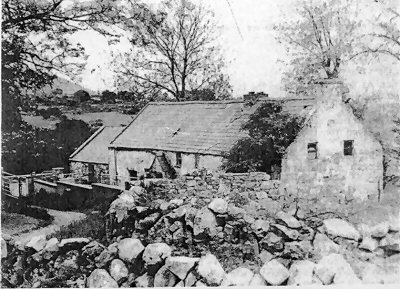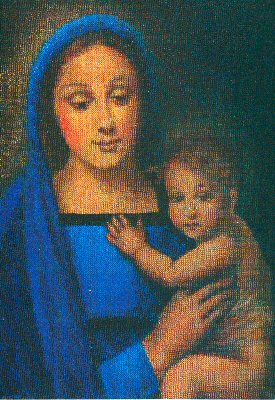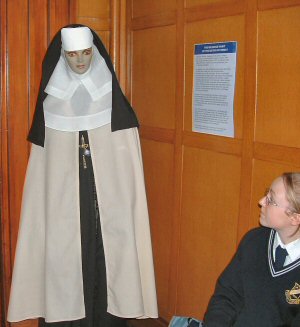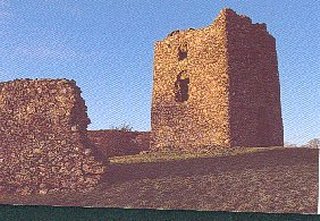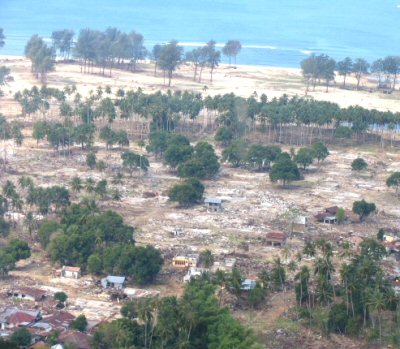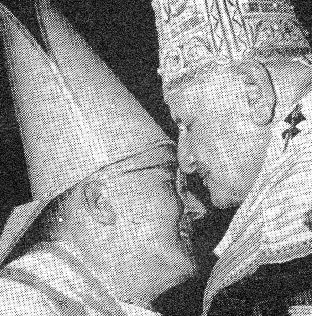Mention was made earlier (History: Religious History: Moninna) that the Killeavy monastery formerly of the holy women who followed S Moninna, had by the mid-sixteenth century reverted to the care of the Culdees, when the Tudor monarchs decided to ‘dissolve’ the monasteries and seize their Church lands. So who were the Culdees? The Catholic Encyclopaedia explains.
In the Irish language the word was written Ceile-De, meaning companion, or even spouse, of God. In the beginning, the Culdees were separated from the mass of the faithful, their lives were devoted to religion, and they lived in a community. In the Irish annals the epithet Ceile-De is appropriately given to St. John, one of the twelve Apostles, to a missioner from abroad whose coming to Ireland is recorded in the Four Masters at the year 806, and to Aengus, the well-known monk and author of Tallaght, whose penances and mortifications, whose humility, piety, and religious zeal, specially marked him out.
The Culdees were holy men who loved solitude and lived by the labour of their hands. Gradually they came together in community, still occupying separate cells, still much alone and in communion with God, but meeting in the refectory and in the church, and giving obedience to a common superior. St. Maelruan, under whom Aengus lived, and who died as early as 792, drew up a rule for the Culdees of Tallaght which prescribed the time and manner of their prayers, fasts, and devotions, the frequency with which they ought to go to confession, the penances to be imposed for faults committed. But we have no evidence that this rule was widely accepted even in the other Culdean establishments. Nor could the Culdees at any time be said to have attained to the position of a religious order, composed of many houses, scattered over many lands, bound by a common rule, revering the memory and imitating the virtues of their founder, and looking to the parent house from which they sprang, as the children of Columbanus looked to Luxeuil or Bobbio, or the Columban monks looked to Iona. After the death of Maelruan Tallaght is forgotten, and the name Ceile-De disappears from the Irish annals until 919, when the Four Masters record that Armagh was plundered by the Danes, but that the houses of prayer, “with the people of God, that is Ceile-De“, were spared. Subsequent entries in the annals show that there were Culdees at Clonmacnoise, Clondalken, and Clones, at Monahincha in Tipperary, and at Scattery Island.
To those of the eighth century, such as were represented by Aengus, were soon added secular priests who assumed the name of Culdees, lived in community, subjected themselves to monastic discipline, but were not bound by monastic vows. Such an order of priests had, in the middle of the eighth century, been founded at Metz. As they lived according to rules and canons of councils, they came to be called secular canons and were usually attached to collegiate or cathedral churches. They became popular and quickly extended even to Ireland, and it is significant that in the accounts given of the Culdee establishments at Clones, Devenish, and Scattery Island, Culdee and canon are taken as convertible terms. The Danish wars, which brought ruin on so many proud monastic establishments, easily effected the destruction of the Culdee houses with their feebler resisting powers. At Clonmacnoise, as early as the eleventh century, the Culdees were laymen and married, while those at Monahincha and Scattery Island being utterly corrupt and unable, or unwilling, to reform, gave way to the regular canons, with their purer morals and stricter discipline.
Those at Armagh were more tenacious of existence. Like their brethren throughout Ireland, they had felt the corrupting influence of the Danish wars; and while lay abbots ruled at Armagh the Culdees had so far departed from their primitive piety that in the twelfth century regular canons were introduced in to the cathedral church and henceforth took precedence of the Culdees. But the latter, six in number, a prior and five vicars, still continued a corporate existence at Armagh. They were specially charged with the celebration of the Divine offices and the care of the church building, had separate lands, and sometimes had charges of parishes. When a chapter was formed, about 1160, the prior usually filled the office of precentor, his brethren being vicars choral, and himself ranking in the chapter next to the chancellor. He was elected by his brother Culdees and confirmed by the primate, and had a voice in the election of the archbishop by virtue of his position in the chapter. As Ulster was the last of the Irish provinces to be brought effectually under English rule, the Armagh Culdees long outlived their brethren throughout Ireland. By the end of Elizabeth‘s reign, however, they had died out, and in 1628, a new body was incorporated by Charles I – the “Prior and Vicars Choral” of the cathedral church of Armagh – to which were transferred the lands formerly held by the Culdees. Five years later, the Catholic primate, O’Reilly, announced to Rome that he had been elected “Prior of the College of the Culdees”, and he wanted to know if in assuming the title he had acted in accordance with canon law. We do not know what was the nature of the answer he received, but this is the last mention made of the Irish Culdees.
Appearing, then, first in Ireland, they subsequently appeared in Scotland, and in both countries their history and fate are almost identical. Attached to cathedral or collegiate churches, living in monastic fashion, though not taking monastic vows, the Scotch, like the Irish Culdees, were originally men of piety and zeal. The turbulence of the times and the acquisition of wealth sowed the seeds of decay, zeal gave way to indolence and neglect, a celibate community to married men, church property was squandered or alienated, even the altar offering, grasped by avarice, were diverted to personal uses, and by the end of he thirteenth century the Scotch Culdee houses had in almost every case disappeared.

